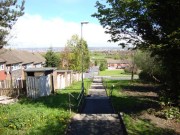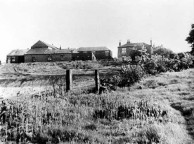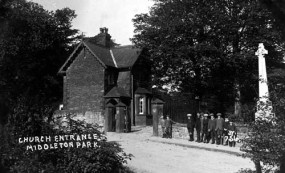Paul Hebden, one of the core group members of the Middleton Life History Group (MLHG), has put together a short circular tour around Middleton pointing out some of the landmarks and history of Middleton.
The walk starts from the Water Tower built in 1924, and moves east along the Ring Roa d towards the shopping centre and the new ASDA.
d towards the shopping centre and the new ASDA.
The first point of interest is the road to your right – Bodmin Approach. The local children used to call this Dangerous Hill because of the old road sign. This at one time would have been part of the old route from Middleton to Morley, a continuation of Town Street. Middleton meaning the middle town, in this case between Rothwell and Morley.
On this part of the walk you are following the remains of the Tram track which has left the park just before the Water Tower and can be plainly seen as a wide strip of grass to y our left. Routes 12 (anticlockwise) and 26 (clockwise) formed the Middleton Circular. They were amongst the few lines to start and finish in the city centre, its terminus was Swinegate. Some of the trams used on this route were specially designed four axle
our left. Routes 12 (anticlockwise) and 26 (clockwise) formed the Middleton Circular. They were amongst the few lines to start and finish in the city centre, its terminus was Swinegate. Some of the trams used on this route were specially designed four axle
trams known as the Middleton bogies. Painted in a Blue and White livery they soon became known as the ‘Middleton Bluebirds’. As can still be seen, a large part of this route ran on reserved track (separated from road traffic) in places parallel to the Middleton railway and then through Middleton woods. The tram network in Leeds closed in 1959.
At the ci rcus on the left can be seen the new Aldi. This replaced the Middleton Arms that opened in 1925 and boasted of a ballroom and tennis courts. This iconic building was demolished in 2013. Behind Aldi is St Philips Church and school opened in 1996 This replaced a Victorian
rcus on the left can be seen the new Aldi. This replaced the Middleton Arms that opened in 1925 and boasted of a ballroom and tennis courts. This iconic building was demolished in 2013. Behind Aldi is St Philips Church and school opened in 1996 This replaced a Victorian
church and was moved stone by stone from Wellington Street Leeds to Middleton in the 1930s but was originally built in 1847.
The Middleton Arms was originally the northern most edge of the new Middleton estate that was built after the First World War as houses in Holbeck and Hunslet were clea red and Middleton was seen as a garden suburb. The main part of the estate lies to the south.
red and Middleton was seen as a garden suburb. The main part of the estate lies to the south.
Continue with the tram track to your left until you see the parade of shops on the left. This area is the Lingwells ( from the word Lingones) remembering Middleton’s Roman heritage. The first building is the Middleton Co-op built 1924 now converted into flats. Behind this building is the Parochial Hall built in 1935 at a cost of £3000 belonging to St Marys church.
Pass the Conservative Club opened in 1936 on your right, behind this building was the Miners Welfare ground. Children from St Marys School would use this for their sports activities. Over the road on the left can be seen Hopewell View and its row of old cottages. This is the southern part of old Middleton Village.
This part of the walk ends at the District shopping centre, the new Asda and the old Middleton Bus Garage.
Cross over the road, walk north down Sharp Lane and join Town Street,
 This triangular area, the junction between Town Street and Sharp Lane, was known as Lingwell Syke. Where the dental surgery and private houses now stand there were cottages marking the Toll Bar which divided Middleton from the surrounding villages.
This triangular area, the junction between Town Street and Sharp Lane, was known as Lingwell Syke. Where the dental surgery and private houses now stand there were cottages marking the Toll Bar which divided Middleton from the surrounding villages.
Walk up Town St, back towards the Water  Tower. On your right is New Hall. All that is left of the New Hall is the name given to this post war housing estate on the right. At one time it was one of the three large houses which stood in Middleton, the others were Middleton Hall on Town Street and Middleton Lodge in the Park. One of its owners was William Gasgoigne the inventor of the Micrometer who was killed in 1644 fighting for Charles the first.
Tower. On your right is New Hall. All that is left of the New Hall is the name given to this post war housing estate on the right. At one time it was one of the three large houses which stood in Middleton, the others were Middleton Hall on Town Street and Middleton Lodge in the Park. One of its owners was William Gasgoigne the inventor of the Micrometer who was killed in 1644 fighting for Charles the first.
Winding Gear. This was where full coal waggons from the Middleton mines were lowered down to Middleton Broom on a counter balance system pulling empty waggons up the incline. Past the row of three old cottages on your right is the site of the old horizontal wind ing wheel and brake. This incline was called Rope Hill. Today the modern steps follow this route – Rope Hill
ing wheel and brake. This incline was called Rope Hill. Today the modern steps follow this route – Rope Hill

Coal Staithes were on the opposite side of Town Street and coal from Middleton was stored here before crossing the road and on to the incline and then into Leeds. The row of houses now on this site are named Staithe Gardens and  Staithe Avenue.
Staithe Avenue.
On your left just past the row of shops is Chapel Hill. The first Methodist chapel on this site was built in 1860 followed in 1876 by the Sunday School. This building became too small and was pulled down and rebuilt in 1896. Miners from the colliery dug the foundations and dressed the bricks in their own time.
The Chapel closed in September 2014.
Back on To wn Street is the old St Marys Church of England School built in 1833 by the Rev R H Brandling and was his own property. Eventually the building and the Estate were bought by The Middleton Colliery Company and leased to the Church, eventually being bought by Leeds City Council. In 1970 the school moved to new buldings in Moor Flatts Road. The old building has been
wn Street is the old St Marys Church of England School built in 1833 by the Rev R H Brandling and was his own property. Eventually the building and the Estate were bought by The Middleton Colliery Company and leased to the Church, eventually being bought by Leeds City Council. In 1970 the school moved to new buldings in Moor Flatts Road. The old building has been
extended and converted into flats.
Manor Farm. One of the last farms to be developed This stood on Town Street and was a stone built farmhouse with 1000 acres of land. Now the Manor Farm E state.
Stone Sleepers Many of the stone walls in this area are capped with stone sleepers from the Middleton Railway. Some can be seen to have two holes made in the top to hold the rails.
Maude Hall was originally a cottage and stables and was purchased by the Churc h Council and converted into a Parish Hall. The money for the Hall
h Council and converted into a Parish Hall. The money for the Hall
was donated by Miss Maude who lived in Middleton Lodge, so it was named the Maude Memorial Hall or the Maude Hall as most people still call it. Children from St Marys C of E school had lessons there as well as school dinners. It has now been converted into a private house.
Behind the Maude Hall is the old vicarage. This replaced the original vicarage built at the same time as the church but demolished in the 1960s. This is now a private house
St Marys Church was built in 1846 by the miners of Middleton (a weeks work or donate a weeks pay). Origina lly built with a spire this was removed in 1939 due to mining subsidence which still affects the church today. See the west wall.
lly built with a spire this was removed in 1939 due to mining subsidence which still affects the church today. See the west wall.

War memorial. This was erected in 1920 to commemorate the fallen in the First World War. It was paid for by public subscription.
 Gate House (lodge) The tall stone gatehouse at the side of the church, now a private house, was part of the Middleton Hall estate. The path to the right of the lodge is called The Drift (possibly after a nearby mine shaft) and was once a carriageway into the park.
Gate House (lodge) The tall stone gatehouse at the side of the church, now a private house, was part of the Middleton Hall estate. The path to the right of the lodge is called The Drift (possibly after a nearby mine shaft) and was once a carriageway into the park.
Middleton Hall. This Georgian mansion stood on
Town Street where Brand ling Court is now. It was once the home of the Brandling family until 1754 and then occupied by John Blenkinsop from 1808 until 1831. John Blenkinsop was the inventor of the rack and pinion railway in 1811. In 1945 the Polish Free Forces were lodged in huts in the grounds of the Hall. The Hall burnt down in 1962 when being used by the council.
ling Court is now. It was once the home of the Brandling family until 1754 and then occupied by John Blenkinsop from 1808 until 1831. John Blenkinsop was the inventor of the rack and pinion railway in 1811. In 1945 the Polish Free Forces were lodged in huts in the grounds of the Hall. The Hall burnt down in 1962 when being used by the council.
 Miss Maudes Way At the start of the park stone walls is an overgrown locked metal gate. This led to a path into the park before the main gates were built. On the site to the right was once the Estate coachmans house .
Miss Maudes Way At the start of the park stone walls is an overgrown locked metal gate. This led to a path into the park before the main gates were built. On the site to the right was once the Estate coachmans house .
The main gates to  the park which have been recently rebuilt, were originally installed when the Estate was bought by Wades charity and leased to the council in 1920. Local children have designed the mosaics on the stone pillars.
the park which have been recently rebuilt, were originally installed when the Estate was bought by Wades charity and leased to the council in 1920. Local children have designed the mosaics on the stone pillars.

Middleton Park Leeds City Council and Friends Of Middleton Park (FOMP) have produced four excellent leaflets (obtainable from the Lakeside Centre) of trails around the park
We continue our route on to…………..

Top of the Town Cottages
These cottages were built in the 1700’s on the other side of Town Street from West Farm. These have remained mainly unchanged.
At the top end of the park was another Lodge of which nothing remains apart from a very grainy photograph.
Continue along to the Water Tower and the end of our tour.
Hope you’ve enjoyed it – for real or ‘virtual’.
(This is an ongoing project and we hope to produce a further walk(s) with points of interest in the future).
PH 8/6/15
